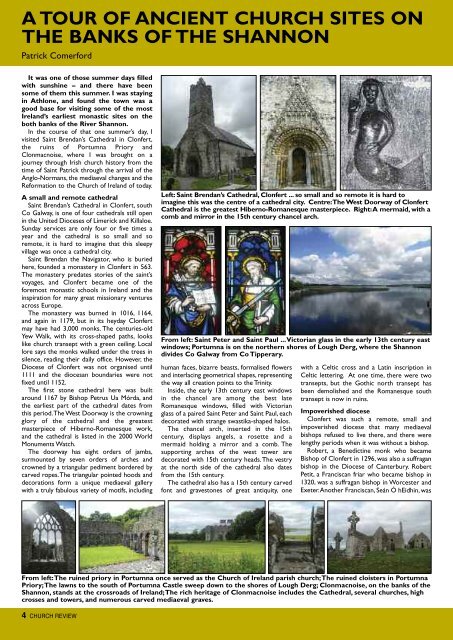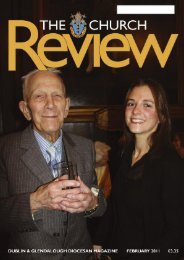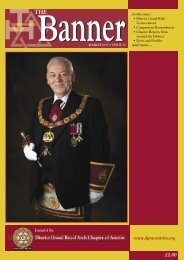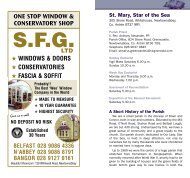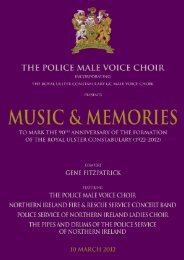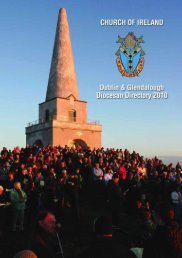church review
church review
church review
Create successful ePaper yourself
Turn your PDF publications into a flip-book with our unique Google optimized e-Paper software.
A TOUR OF ANCIENT CHURCH SITES ON<br />
THE BANKS OF THE SHANNON<br />
Patrick Comerford<br />
It was one of those summer days filled<br />
with sunshine – and there have been<br />
some of them this summer. I was staying<br />
in Athlone, and found the town was a<br />
good base for visiting some of the most<br />
Ireland’s earliest monastic sites on the<br />
both banks of the River Shannon.<br />
In the course of that one summer’s day, I<br />
visited Saint Brendan’s Cathedral in Clonfert,<br />
the ruins of Portumna Priory and<br />
Clonmacnoise, where I was brought on a<br />
journey through Irish <strong>church</strong> history from the<br />
time of Saint Patrick through the arrival of the<br />
Anglo-Normans, the mediaeval changes and the<br />
Reformation to the Church of Ireland of today.<br />
A small and remote cathedral<br />
Saint Brendan’s Cathedral in Clonfert, south<br />
Co Galway, is one of four cathedrals still open<br />
in the United Dioceses of Limerick and Killaloe.<br />
Sunday services are only four or five times a<br />
year and the cathedral is so small and so<br />
remote, it is hard to imagine that this sleepy<br />
village was once a cathedral city.<br />
Saint Brendan the Navigator, who is buried<br />
here, founded a monastery in Clonfert in 563.<br />
The monastery predates stories of the saint’s<br />
voyages, and Clonfert became one of the<br />
foremost monastic schools in Ireland and the<br />
inspiration for many great missionary ventures<br />
across Europe.<br />
The monastery was burned in 1016, 1164,<br />
and again in 1179, but in its heyday Clonfert<br />
may have had 3,000 monks. The centuries-old<br />
Yew Walk, with its cross-shaped paths, looks<br />
like <strong>church</strong> transept with a green ceiling. Local<br />
lore says the monks walked under the trees in<br />
silence, reading their daily office. However, the<br />
Diocese of Clonfert was not organised until<br />
1111 and the diocesan boundaries were not<br />
fixed until 1152.<br />
The first stone cathedral here was built<br />
around 1167 by Bishop Petrus Ua Mórda, and<br />
the earliest part of the cathedral dates from<br />
this period. The West Doorway is the crowning<br />
glory of the cathedral and the greatest<br />
masterpiece of Hiberno-Romanesque work,<br />
and the cathedral is listed in the 2000 World<br />
Monuments Watch.<br />
The doorway has eight orders of jambs,<br />
surmounted by seven orders of arches and<br />
crowned by a triangular pediment bordered by<br />
carved ropes. The triangular pointed hoods and<br />
decorations form a unique mediaeval gallery<br />
with a truly fabulous variety of motifs, including<br />
Left: Saint Brendan’s Cathedral, Clonfert ... so small and so remote it is hard to<br />
imagine this was the centre of a cathedral city. Centre: The West Doorway of Clonfert<br />
Cathedral is the greatest Hiberno-Romanesque masterpiece. Right: A mermaid, with a<br />
comb and mirror in the 15th century chancel arch.<br />
From left: Saint Peter and Saint Paul ... Victorian glass in the early 13th century east<br />
windows; Portumna is on the northern shores of Lough Derg, where the Shannon<br />
divides Co Galway from Co Tipperary.<br />
human faces, bizarre beasts, formalised flowers<br />
and interlacing geometrical shapes, representing<br />
the way all creation points to the Trinity.<br />
Inside, the early 13th century east windows<br />
in the chancel are among the best late<br />
Romanesque windows, filled with Victorian<br />
glass of a paired Saint Peter and Saint Paul, each<br />
decorated with strange swastika-shaped halos.<br />
The chancel arch, inserted in the 15th<br />
century, displays angels, a rosette and a<br />
mermaid holding a mirror and a comb. The<br />
supporting arches of the west tower are<br />
decorated with 15th century heads. The vestry<br />
at the north side of the cathedral also dates<br />
from the 15th century.<br />
The cathedral also has a 15th century carved<br />
font and gravestones of great antiquity, one<br />
with a Celtic cross and a Latin inscription in<br />
Celtic lettering. At one time, there were two<br />
transepts, but the Gothic north transept has<br />
been demolished and the Romanesque south<br />
transept is now in ruins.<br />
Impoverished diocese<br />
Clonfert was such a remote, small and<br />
impoverished diocese that many mediaeval<br />
bishops refused to live there, and there were<br />
lengthy periods when it was without a bishop.<br />
Robert, a Benedictine monk who became<br />
Bishop of Clonfert in 1296, was also a suffragan<br />
bishop in the Diocese of Canterbury. Robert<br />
Petit, a Franciscan friar who became bishop in<br />
1320, was a suffragan bishop in Worcester and<br />
Exeter. Another Franciscan, Seán Ó hEidhin, was<br />
From left: The ruined priory in Portumna once served as the Church of Ireland parish <strong>church</strong>; The ruined cloisters in Portumna<br />
Priory; The lawns to the south of Portumna Castle sweep down to the shores of Lough Derg; Clonmacnoise, on the banks of the<br />
Shannon, stands at the crossroads of Ireland; The rich heritage of Clonmacnoise includes the Cathedral, several <strong>church</strong>es, high<br />
crosses and towers, and numerous carved mediaeval graves.<br />
4 ChURCh RevIeW


